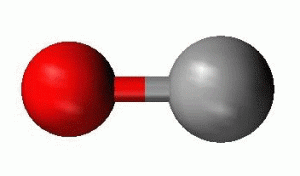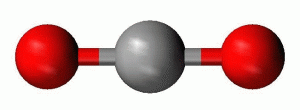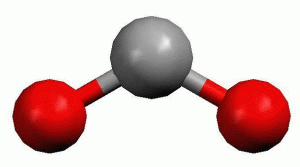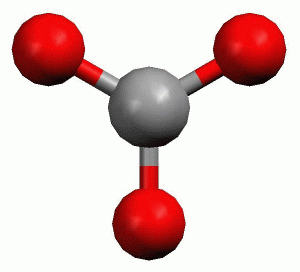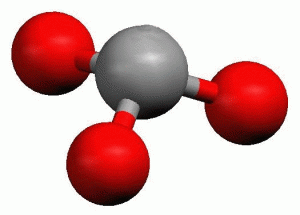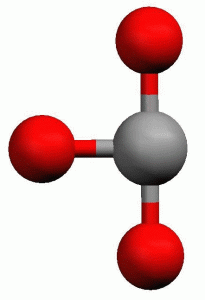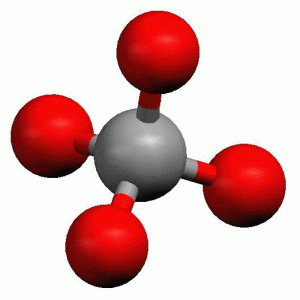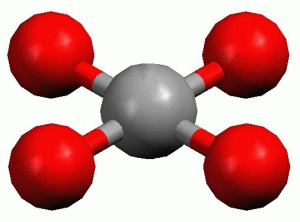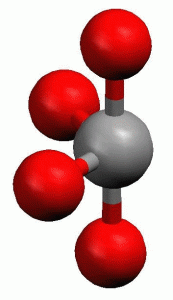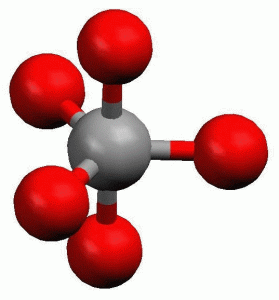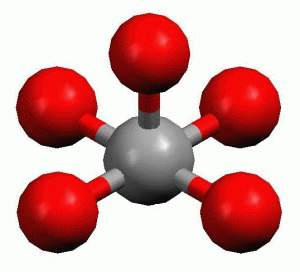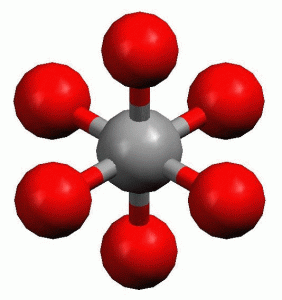Molecular Modeling 1: Classic Molecular Modeling
Author: J. M. McCormick*
Last Update: January 31, 2011
Introduction
Dalton’s Atomic Theory revolutionized chemistry by explaining chemical properties in terms of small, indivisible pieces of matter called atoms that are linked together to form polyatomic species (both ions and molecules). As chemists explored the properties of the polyatomic species, it became clear that they have size and shape and that shape is particularly important in explaining their physical properties and why and how chemical reactions occur. A summary of some of the commonly observed polyatomic shapes (also known as structures or geometries) are shown in Table 1 arranged by the number of atoms around the “central atom.” These are idealized structures; real molecules seldom exhibit these idealized shapes. However, the ideal shapes are good starting points toward understanding how the spatial arrangement of atoms in polyatomic species affect their properties and chemistry.
Table 1. Summary of idealized common structures of molecules and polyatomic ions.
Chemists often find it convenient to build a model of a molecule or polyatomic ion to help them visualize its actual shape, much in the same as an architect will build a model of a building to help him or her see its structure. The complexity of the model a chemist will use is dictated by the answer sought. And the explanation as to why a molecule or polyatomic ion has a certain structure depends on the theory used.
The simplest model is a Lewis dot structure which gives us an approximate picture of the bonding interactions that hold the polyatomic species together. It does not, however, give an accurate picture of structure or the electrons’ energies. Because Lewis dot structures assume that all valence electrons are paired and a chemical bond requires two electrons, it is limited to simple compounds of the main group elements (s and p blocks) and some transition metal ions (those with d0 and d10 configurations). A Lewis dot structure can be used to obtain a rough picture of structure by using Valence Shell Electron Pair Repulsion (VSEPR) theory.
IIn VSEPR theory we assume that the electron pairs, whether in bonds or in lone pairs, take up space and repel each other. The final arrangement of the atoms is determined in VSEPR theory by the jostling of the electrons for space. VSEPR theory gives reasonable predictions of structure and can explain why certain polyatomic species are distorted relative to an ideal geometry. It suffers from the same limitations as Lewis dot structures. And the structures that VSEPR predicts are really only valid in the gaseous state because it ignores interactions between species.
VSEPR theory only predicts structure and cannot be used, by itself, to describe the places where electrons are allowed to be (i. e., the molecular orbitals). Valence Bond theory allows us to take a VSEPR structure (or a real structure) and get a rough idea of how the electron density is distributed in bond. As with the other models a number of simplifying approximations have been made and we still cannot get energies for a polyatomic species. The hybrid orbitals that are used to explain bonding in Valence Bond theory do give us a reasonable approximation of how the electrons distribute themselves for many chemical species (the molecular orbitals). For relatively simple systems, like compounds formed by elements of the first two periods, the combination of Lewis dot, VSEPR and Valence Bond theories is sufficient to explain most of their chemistry.
The most complete theory is Molecular Orbital (MO) theory which considers the energies of the atomic orbitals and how well the atomic orbitals on different atoms overlap. In MO theory it is the balance between orbital energy and overlap that ultimately determines structure. MO theory can give a very accurate description of structure, electron arrangement and molecular energies, but it is neither quick nor simple to apply. So unless a detailed picture of molecular structure is required, one of the simpler models is used.
This exercise will give you practice in using Lewis dot structures, VSEPR and Valence Bond theory models. We will also be exploring the ramifications of molecular shape and how to describe shape in mathematical terms. NOTE! Your instructor may use this exercise in any one of a number of ways. Be sure that you understand what he or she wants you do before coming to laboratory.
Experimental
Do not write this exercise up in your notebook. There are worksheets for the eight groups of molecules and ions (click on the links below to obtain these worksheets in PDF format, print them out and bring them to laboratory).
In this exercise you will be using a traditional model kit to build models of a number of molecules and polyatomic ions. Most of the balls in the kit have only one hole drilled in them. These are used to model atoms that have only one connection to another atom where we can ignore the disposition of any lone pairs (i. e., terminal atoms). There are balls drilled for the ideal angles for tetrahedral, trigonal bipyramidal and octahedral geometries. Your kit may have red balls, representing oxygen, drilled with only two holes instead of four because the positions of the lone pairs have already been taken into account. See Table 2 for the correspondence between ball color and element.
| Color | Number of Holes | Element Represented |
|---|---|---|
| White | 1 | Hydrogen |
| Green | 1 | Chlorine |
| Orange | 1 | Bromine |
| Purple | 1 | Iodine |
| Red | 2 | Oxygen |
| Yellow | 2 | Sulfur |
| Blue | 4 | Nitrogen |
| Black | 4 | Carbon |
| Brown | 5 | Element with an expanded octet |
| Silver | 6 | Element with an expanded octet |
Table 2. Key to the atoms in the molecular model kit. Any color may be used to represent any element not listed, as long as the number of bonds and the disposition of the lone pairs match.
The stiff, gray connectors are used for single bonds and the flexible, gray connectors are used for multiple bonds. Do not use the short white connectors (they are hard to get out). Because the connector representing bonds are the same size and the balls used to model the atoms are not to scale, the models give inexact representations of the molecules and ions. But, they are useful for observing the connectivity and the three-dimensional arrangement of atoms in space.
If directed by your instructor, before coming to laboratory draw Lewis dot structures for each of the species on the worksheets (use a pencil!). Show all contributing resonance structures, where appropriate (use the back of the page, if necessary), and consider formal charges as needed. Click here to review Lewis dot structures.
Predict the electron pair geometry (also known as the “stereochemical formula”), and the molecular geometries for each chemical species using VSEPR. Below the picture of each molecule write the name of the geometry (e. g. linear, trigonal planar, etc.). Although you do not need to name the molecular shape for molecules and ions with more than one “central atom”, you should be able to indicate the molecular geometry about each “central atom.” Click here to review VSEPR theory.
During lab construct a molecular model, using the kit provided, for each species listed in the tables. Do not make models for species where resonance is important (e. g., species in Group B and Group E) because these models will mislead you into thinking that there are double and single bonds in these species where there are not. Verify that your predicted geometries are the same as what you obtain with the models. Correct any errors in your table, and use the models as an aid to fill in any blank spaces. When writing the electron pair or molecular geometry for a species with a double or triple bond, just draw two or three straight lines, not curved lines.
After you have made a model check to see if it is included in Group H. If it is, examine its symmetry and use the table in Group H to find the different ways the molecule or ion can be rotated, reflected or inverted to give a configuration that is identical to the starting configuration. Fill in the Group H table.
Predict whether the molecule is “polar” or “non-polar”. You do not need to indicate polarity for species with an entry of “—” in the polarity column. For ions this is because the electrostatic forces involved are much stronger than forces involving dipoles.
Results and Analysis
Click here to download a worksheet of questions to answer after you have finished this exercise.
Conclusions
There are no conclusions to write for this exercise.
- 1. Click here to obtain this file in PDF format. Note that hyperlinks are not active in the pdf version.
- 2. Zumdahl, S. S. Chemical Principles, 4th Ed.; Houghton-Mifflin: New York, 2002, chapters 13 and 14.
- 3. Gillespie, R. J. and Popelier, P. L. A. Chemical Bonding and Molecular Geometry: from Lewis to Electron Densities; Oxford University Press: New York, 2001.
- 4. Gray, H. B. Electrons and Chemical Bonding; W. A. Benjamin: New York, 1964.
- 5. Ballhausen, C. J. and Gray, H. B. Molecular Orbital Theory; Benjamin-Cummings: Reading, MA, 1964.
- 6. Pauling, L. The Nature of the Chemical Bond and the Structure of Molecules and Crystals; Cornell University Press: Ithaca, NY, 1960.

